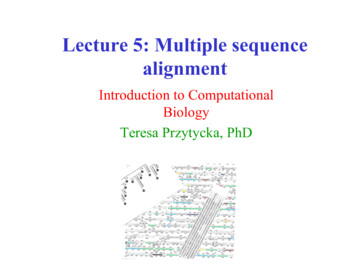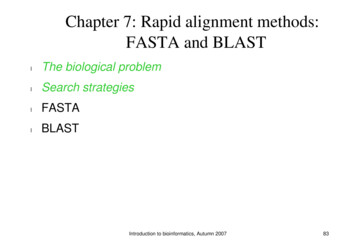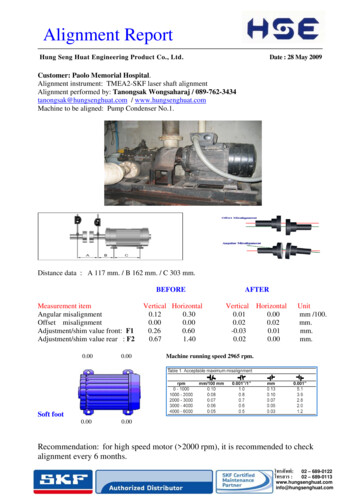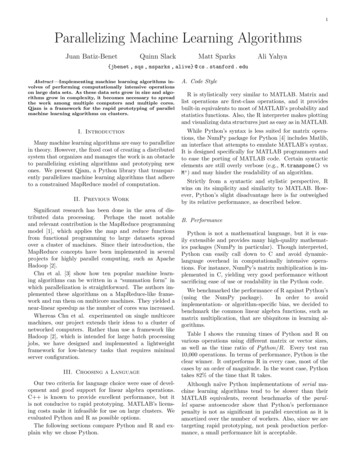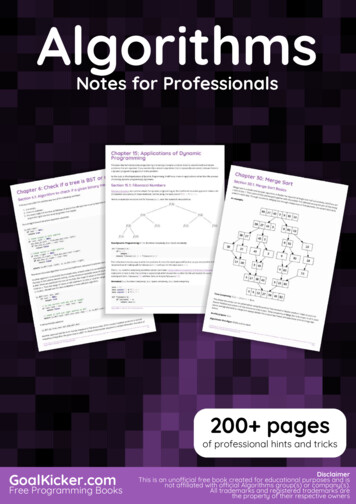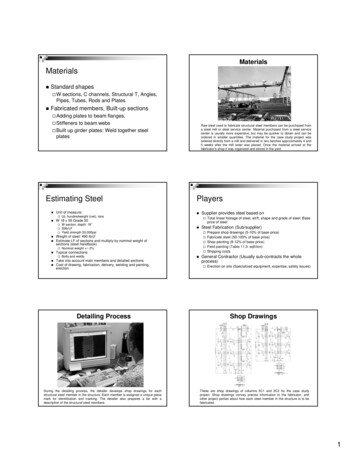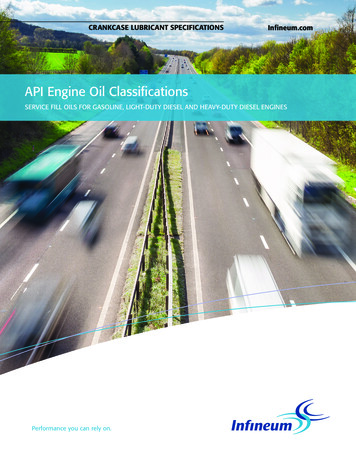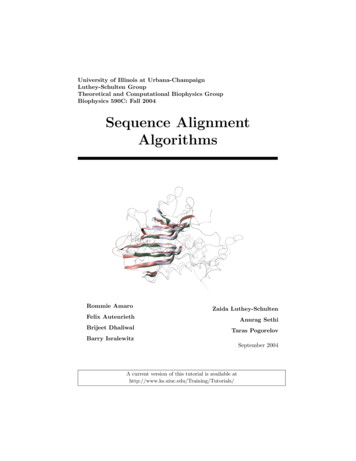
Transcription
University of Illinois at Urbana-ChampaignLuthey-Schulten GroupTheoretical and Computational Biophysics GroupBiophysics 590C: Fall 2004Sequence AlignmentAlgorithmsRommie AmaroZaida Luthey-SchultenFelix AutenriethBrijeet DhaliwalAnurag SethiTaras PogorelovBarry IsralewitzSeptember 2004A current version of this tutorial is available athttp://www.ks.uiuc.edu/Training/Tutorials/
CONTENTS2Contents1 Introduction2 Sequence Alignment Algorithms2.1 Manually perform a Needleman-Wunsch alignment . . . . . . . .2.2 Finding homologous pairs of ClassII tRNA synthetases . . . . . .35510
11INTRODUCTION3IntroductionThe recent developments of projects such as the sequencing of the genome fromseveral organisms, and high-throughput X-ray structure analysis, have broughta large amount of data about the sequences and structures of several thousandproteins to the scientific community. This information can be used effectively formedical and biological research only if one can extract functional insight fromthe sequence and structural data. To achieve this we need to understand how theproteins perform their functions. Two main computational techniques exist toreach this a goal: a bioinformatics approach, and atomistic molecular dynamicssimulations. Bioinformatics uses the statistical analysis of protein sequencesand structures to understand their function and predict structures when onlysequence information is available. Molecular modeling and molecular dynamicssimulations use principles from physics and physical chemistry to study thefunction and folding of proteins.Bioinformatics methods are among the most powerful technologies availablein life sciences today. They are used in fundamental research on theories ofevolution and in more practical considerations of protein design. Algorithms andapproaches used in these studies range from sequence and structure alignments,secondary structure prediction, functional classification of proteins, threadingand modeling of distantly-related homologous proteins to modeling the progressof protein expression through a cell’s life cycle.In this tutorial you will use a classic global sequence alignment method, theNeedleman-Wunsch algorithm, to align two small proteins. First you will alignthem by hand and perform your own dynamic programming; afterwards youwill check your work against a computer program that we provide you. TheNeedleman-Wunsch alignment programs have been kindly provided by AnuragSethi.The entire tutorial takes about an hour to complete in its entirity.Protein sequences vs. nucleotide sequences. A protein is a sequence of amino acids linked with peptide bonds to form a polypeptide chain. In this tutorial, the word sequence (unless otherwisespecified) refers to the amino acid residue sequence of a protein; byconvention these sequences are listed from the N-terminal to the Cterminal of the chain. Sequences can be written with full names, asin “Lysine, Arginine, Cysteine, .”, with 3-letter codes, “Lys, Arg,Cys, .”, or with 1-letter codes, “K, R, C, .” . Proteins range insize from a few dozen to several thousand residues. The nucleotidesequences of DNA encodes protein sequence. Sections of genes inchromosomal DNA are copied to mRNA, which provides the guidefor ribosome to assemble a protein. A nucleotide sequence may bewritten as “Cytosine, Adenine, Adenine, Guanine, .”, or “C, A, A,G, .”.This tutorial assumes that the alignment programs we provide you have beencorrectly installed on the user’s computer. Please ask a lab attendant for helpif you have any trouble locating software or data files during the tutorial.
1INTRODUCTION4Getting startedThe files for this tutorial are located in: mkdir /Workshop/bioinformatics-tutorial/Within this directory is the pdf for the tutorial, as well as the files needed forrunning the tutorial. Before you start the tutorial, be sure you are in the directory with all the files: /Workshop/bioinformatics-tutorial/bioinformatics
2SEQUENCE ALIGNMENT ALGORITHMS25Sequence Alignment AlgorithmsIn this section you will optimally align two short protein sequences using penand paper, then search for homologous proteins by using a computer program toalign several, much longer, sequences.Dynamic programming algorithms are recursive algorithms modified to storeintermediate results, which improves efficiency for certain problems. The Needleman–Wunsch algorithm uses a dynamic programming algorithm to find the optimalglobal alignment of two sequences — a and b. The alignment algorithm is basedon finding the elements of a matrix H where the element Hi,j is the optimalscore for aligning the sequence (a1 ,a2 ,.,ai ) with (b1 ,b2 ,.,bj ). Two similaramino acids (e.g. arginine and lysine) receive a high score, two dissimilar aminoacids (e.g. arginine and glycine) receive a low score. The higher the score ofa path through the matrix, the better the alignment. The matrix H is foundby progressively finding the matrix elements, starting at H1,1 and proceedingin the directions of increasing i and j. Each element is set according to: Hi 1,j 1 Si,jHi 1,j dHi,j max Hi,j 1 dwhere Si,j is the similarity score of comparing amino acid ai to amino acidbj (obtained here from the BLOSUM40 similarity table) and d is the penaltyfor a single gap. The matrix is initialized with H0,0 0. When obtaining thelocal Smith-Waterman alignment, Hi,j is modified: 0 Hi 1,j 1 Si,jHi,j maxH i 1,j d Hi,j 1 dThe gap penalty can be modified, for instance, d can be replaced by (d k),where d is the penalty for a single gap and k is the number of consecutive gaps.Once the optimal alignment score is found, the “traceback” through H alongthe optimal path is found, which corresponds to the the optimal sequence alignment for the score. In the next set of exercises you will manually implementthe Needleman-Wunsch alignment for a pair of short sequences, then performglobal sequence alignments with a computer program developed by AnuragSethi, which is based on the Needleman-Wunsch algorithm with an affine gappenalty, d e(k 1), where e is the extension gap penalty. The output file willbe in the GCG format, one of the two standard formats in bioinformatics forstoring sequence information (the other standard format is FASTA).2.1Manually perform a Needleman-Wunsch alignmentIn the first exercise you will test the Needleman-Wunsch algorithm on a shortsequence parts of hemoglobin (PDB code 1AOW) and myoglobin 1 (PDB code1AZI).
2SEQUENCE ALIGNMENT ALGORITHMS6Here you will align the sequence HGSAQVKGHG to the sequence KTEAEMKASEDLKKHGT.The two sequences are arranged in a matrix in Table 1. The sequences start atthe upper right corner, the initial gap penalties are listed at each offset startingposition. With each move from the start position, the initial penalty increaseby our single gap penalty of 56G-64H-72Table 1: The empty matrix with initial gap penalties.G-80
2SEQUENCE ALIGNMENT ALGORITHMS71 The first step is to fill in the similarity scores Si,j from looking up thematches in the BLOSUM40 table, shown here labeled with 1-letter aminoacid 2-1-211-3-20M9-4-2-1140-3-4-1F11-1 50 2 6-4 -5 -4 19-3 -2 -1 3 9-3 -1 1 -3 -1 5-2 0 0 -4 -3 -3 5-1 0 -1 -2 -2 -3 2 5-2 0 0 -2 -1 -1 -1 -1 -1P S T W Y V B Z X
2SEQUENCE ALIGNMENT ALGORITHMS82 We fill in the BLOSUM40 similarity scores for you in Table 2.3 To turn this S matrix intro the dynamic programming H matrix requirescalculation of the contents of all 170 boxes. We’ve calculated the first4 here, and encourage you to calculate the contents of at least 4 more.The practice will come in handy in the next steps. As described above, amatrix square cannot be filled with its dynamic programming value untilthe squares above, to the left, and to the above-left diagonal are computed.The value of a square is,Hi,j Hi 1,j 1 Si,jHi 1,j d max Hi,j 1 dusing the convention that H values appear in the top part of a square inlarge print, and S values appear in the bottom part of a square in smallprint. Our gap penalty d is 8.Example:. In the upper left square in Table 2, square (1,1), thesimilarity score S1,1 is -1, the number in small type at the bottom ofthe box. The value to assign as H1,1 will be the greatest (“max”)of thes e three values: (H0,0 S1,1 ), (H0,1 d), (H1,0 d)). Thatis, the greatest of: (0 1), ( 8 8), ( 8 8) which just meansthe greatest of: -1, -16, and -16. This is -1, so we write -1 as thevalue of H1,1 (the larger number in the top part of the box). Thesame reasoning in square (2,1) leads us to set H2,1 as -9, and soon. Note: we consider H0,0 to be the “predecessor” of H1,1 , sinceit helped decided H1,1 ’s value. Later, predecessors will qualify to beon the traceback path.4 Again, just fill in 4 or 5 boxes in Table 2 until you get a feel for gappenalties and similarity scores S vs. alignment scores H. In the next step,we provide the matrix with all values filled in as Table 2.1. Check thatyour 4 or 5 calculations match.5 Now we move to Table 2.1, with all 170 Hi,j values are shown, to do the“alignment traceback”. To find the alignment requires one to trace thepath through from the end of the sequence (the lower right box) to thestart of the sequence (the upper left box). This job looks complicated,but should only take about 5 –7 minutes.6 We are tracing a path in Table 2.1, from the lower right box to the upperleft box. You can only move to a square if it could have been a “predecessor” of your current square – that is, when the matrix was being filledwith Hi,j values, the move from the predecessor square to your currentsquare would have followed the mathematical rules we used to find Hi,jabove. Circle each square you move to along your path.
2SEQUENCE ALIGNMENT ALGORITHMS9Example:. we start at the lower right square (10,17), where H10,17is -21 and S10,17 is -2. We need to test for 3 possible directions ofmovement: diagonal (up left), up, and left. The condition fordiagonal movement given above is: Hi,j Hi 1,j 1 Si,j , so forthe diagonal box (9,16) to have contributed to (10,17), H9,16 S10,17 would have to equal the H value of our box, -21. Since (-29 -2) does not equal -21, the diagonal box is not a “predecessor”,so we can’t move in that direction. We try the rule for the boxto the left: Hi,j Hi 1,j d Since -37 - 8 does not equal -21,we also can’t move left. Our last chance is moving up. We testHi,j Hi,j 1 d. Since -21 (-13 - 8) we can move up! Drawan arrow from the lower right box, (H10,17 21, S10,17 2) tothe box just above it, (H10,16 13, S10,16 8).7 Continue moving squares, drawing arrows, and circling each new squareyou land on, until you have reached the upper right corner of the matrixIf the path branches, follow both branches.8 Write down the alignment(s) that corresponds to your path(s) by writingthe the letter codes on the margins of each position along your circled path.Aligned pairs are at the boxes at which the path exits via the upper-leftcorner. When there are horizontal or vertical movements movements alongyour path, there will be a gap (write as a dash, “-”) in your sequence.9 Now to check your results against a computer program. We have prepareda pairwise Needleman-Wunsch alignment program, pair, which you willapply to the same sequences which you have just manually aligned.10 Change your directory by typing at the Unix prompt:cd airDatathen start the pair alignment executable by typing:pair targlistAll alignments will be carried out using the BLOSUM40 matrix, with agap penalty of 8. The paths to the input files and the BLOSUM40 matrixused are defined in the file targlist; the BLOSUM40 matrix is the first25 lines of the file blosum40. (Other substitution matrices can be foundat the NCBI/Blast website.)Note: In some installations, the pair executable isin airData andhere you musttype ./pair targlist to run it.If you cannot access the pair executable at all, you can see the output fromthis step in airData/example output/11 After executing the program you will generate three output files namelyalign, scorematrix and stats. View the alignment in GCG format by
2SEQUENCE ALIGNMENT ALGORITHMS10typing less align. The file scorematrix is the 17x10 H matrix. Ifthere are multiple paths along the traceback matrix, the program pairwill choose only one path, by following this precedence rule for existingpotential traceback directions, listed in decreasing preceden ce: diagonal(left and up), up, left. In the file stats you will find the optimal alignmentscore and the percent identity of the alignment.Questions. Compare your manual alignment to the the output ofthe pair program. Do the alignments match?2.2Finding homologous pairs of ClassII tRNA synthetasesHomologous proteins are proteins derived from a common ancestral gene. Inthis exercise with the Needleman-Wunsch algorithm you will study the sequenceidentity of several class II tRNA synthetases, which are either from Eucarya,Eubacteria or Archaea or differ in the kind of aminoacylation reaction whichthey catalyze. Table 4 summarizes the reaction type, the organism and thePDB accession code and chain name of the employed Class II tRNA synthetasedomains.We have have prepared a computer program multiple which will align multiplepairs of proteins.1 Change your directory by typing at the Unix prompt:cd ultipleDatathen start the alignment executable by typing:multiple targlistNote: In some installations, the multiple executable isin ultipleData andhere you musttype ./multiple targlist to run it.If you cannot access the multiple executable at all, you can see the output fromthis step in /Workshop.work/Bioinformatics/multipleData/example output/2 In the align and stats files you will find all combinatorial possible pairsof the provided sequences. On a piece of paper, write the names of the theproteins, grouped by ther domain of life, as listed in Table 4. Comparesequence identities of aligned proteins from the same domain of a life,and of aligned proteins from different domains of life, to help answer thequestions below.
2SEQUENCE ALIGNMENT ALGORITHMS11Questions. What criteria do you use in order to determine if twoproteins are homologous? Can you find a pattern when you evaluatepercent identities between the pairs of class II tRNA synthetases?Which is the most evolutionarily related pair, and which is the mostevolutionarily divergent pair according to the sequence identity?
2SEQUENCE ALIGNMENT ALGORITHMS0KTEAEMKASEDLKKHGT-8-16H-8G-16 1 9 1 2 9 3 2S-24A-3212Q-40V-48K-56G-64H-72G-800 11 26 2 1 2 220 110 2 2 20 30 12 31 30 3 211500 11 210 30 12 31 30 31 2 2 1 11 1 21 2 1 20 11 26 2 1 2 211500 11 21 10511 100 100 30 12 31 30 30 20 1 1 30 20 2 2 4 3 2 22 2 4 2 4 1 20 11 26 2 1 2 1 20 11 26 2 1 213 2 1 20 4 1 213 2 2801 2 4 28 28 2 220 110 2 2 6Table 2: Alignment score worksheet. In all alignment boxes, the similarityscore Si,j from the BLOSUM40 matrix lookup is supplied (small text, bottomof square). Four alignment scores are provided as examples (large text, top ofsquare), try and calculate at least four more, following the direction providedin the text for calculating Hi,j .
2SEQUENCE ALIGNMENT Q-40V-48K-56G-64H-72G-80 1 9 16 24 31 39 42 50 58 66 1 20 11 26 2 1 2 9 3 7 15 23 30 38 44 52 60 2 220 110 2 2 2 16 11 3 8 13 21 29 37 44 520 30 12 31 30 3 24 15 102 6 13 21 28 36 43 211500 11 21 32 23 15 64 4 12 20 28 360 30 12 31 30 3 39 31 23 14 45 3 11 19 271 2 2 1 11 1 21 2 47 39 31 22 12 3113 5 13 1 20 11 26 2 1 2 55 46 38 26 20 113124 4 211500 11 21 63 54 41 34 25 19 54114 10511 100 10 71 62 49 42 32 27 13 4480 30 12 31 30 3 79 70 57 50 40 35 21 12 420 20 1 1 30 20 2 87 78 65 58 48 38 29 20 12 6 2 4 3 2 22 2 4 2 4 95 86 73 66 56 46 32 28 20 14 1 20 11 26 2 1 2 103 94 81 74 64 54 40 34 28 22 1 20 11 26 2 1 2 99 102 89 82 72 62 48 42 21 2913 2 1 20 4 1 213 2 107 91 97 88 80 70 56 40 29 13 2801 2 4 28 28 115 99 89 96 88 78 64 48 37 21 2 220 110 2 2 2Table 3: Traceback worksheet. The completed alignment score matrix H (largetext, top of each square) with the BLOSUM40 lookup scores Si,j (small text,bottom of each square). To find the alignment, trace back starting from thelower right (T vs G, score -21) and proceed diagonally (to the left and up), left,or up. Only proceed, however, if the square in that direction could have been apredecessor, according to the conditions described in the text.
2SEQUENCE ALIGNMENT yaArchaeaEubacteriaEubacteriaEubacteriaPDB :A14ASTRAL catalytic efwa3Table 4: Domain types, origins, and accession codes
Bioinformatics uses the statistical analysis of protein sequences . them by hand and perform your own dynamic programming; afterwards you . Within this directory is the pdf for the tutoria
